Comprehensive Audit Report: DIPL Printing Press Financial Analysis
VerifiedAdded on 2020/03/02
|8
|1161
|38
Report
AI Summary
This report presents an audit of DIPL Printing Press, examining its financial statements, internal controls, and potential risks and fraud. The audit includes substantive and analytical procedures, such as ratio analysis and trend analysis, to assess the company's financial position, profitability, debt management, and liquidity. The report identifies inherent risks related to changes in accounting policies, non-routine work like IT system installation, and lack of segregation of duties, highlighting potential fraud elements. The auditor emphasizes the importance of mitigating these risks through proper controls, verification of documents, and reconciliation of accounts. The analysis incorporates relevant literature and provides recommendations for improving financial reporting and governance.
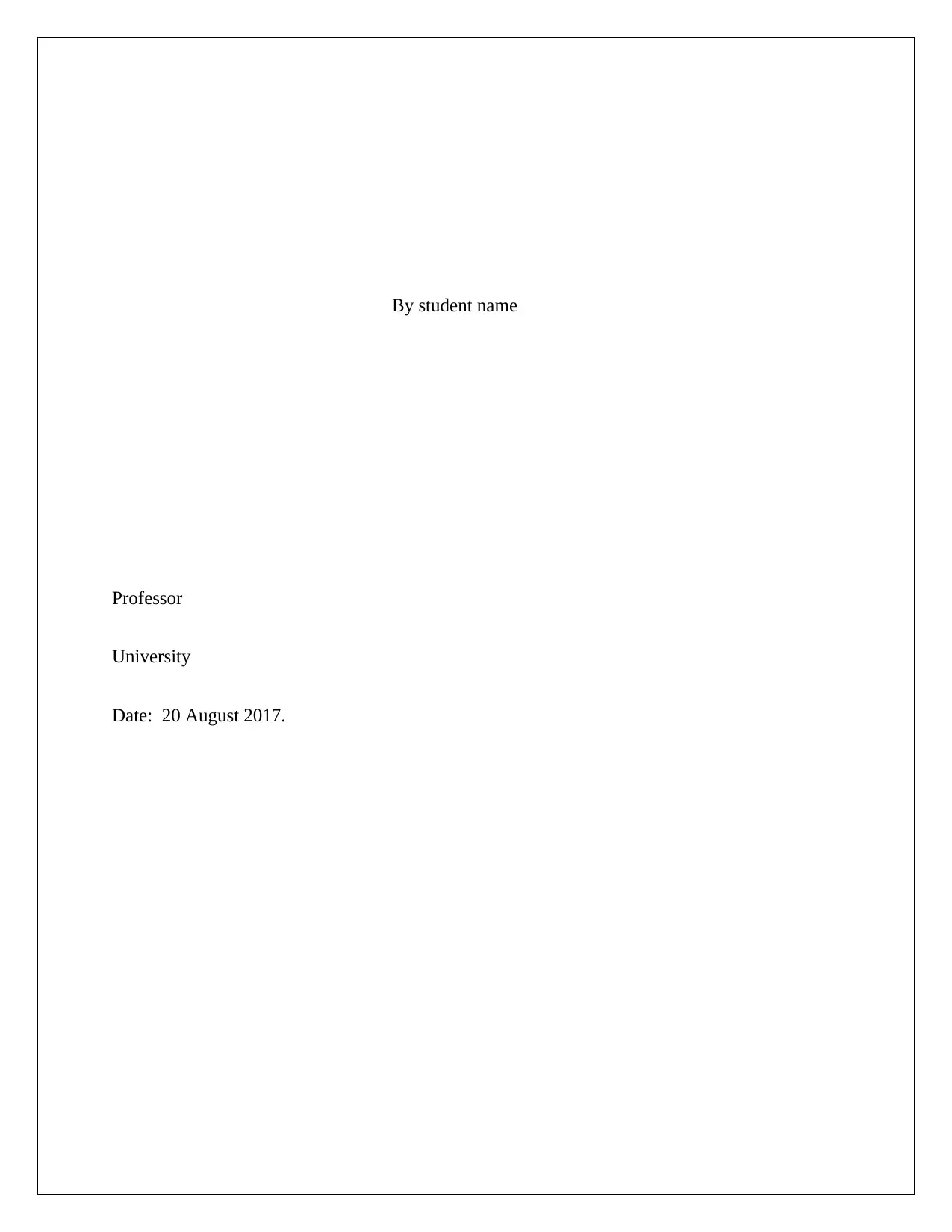
By student name
Professor
University
Date: 20 August 2017.
Professor
University
Date: 20 August 2017.
Paraphrase This Document
Need a fresh take? Get an instant paraphrase of this document with our AI Paraphraser
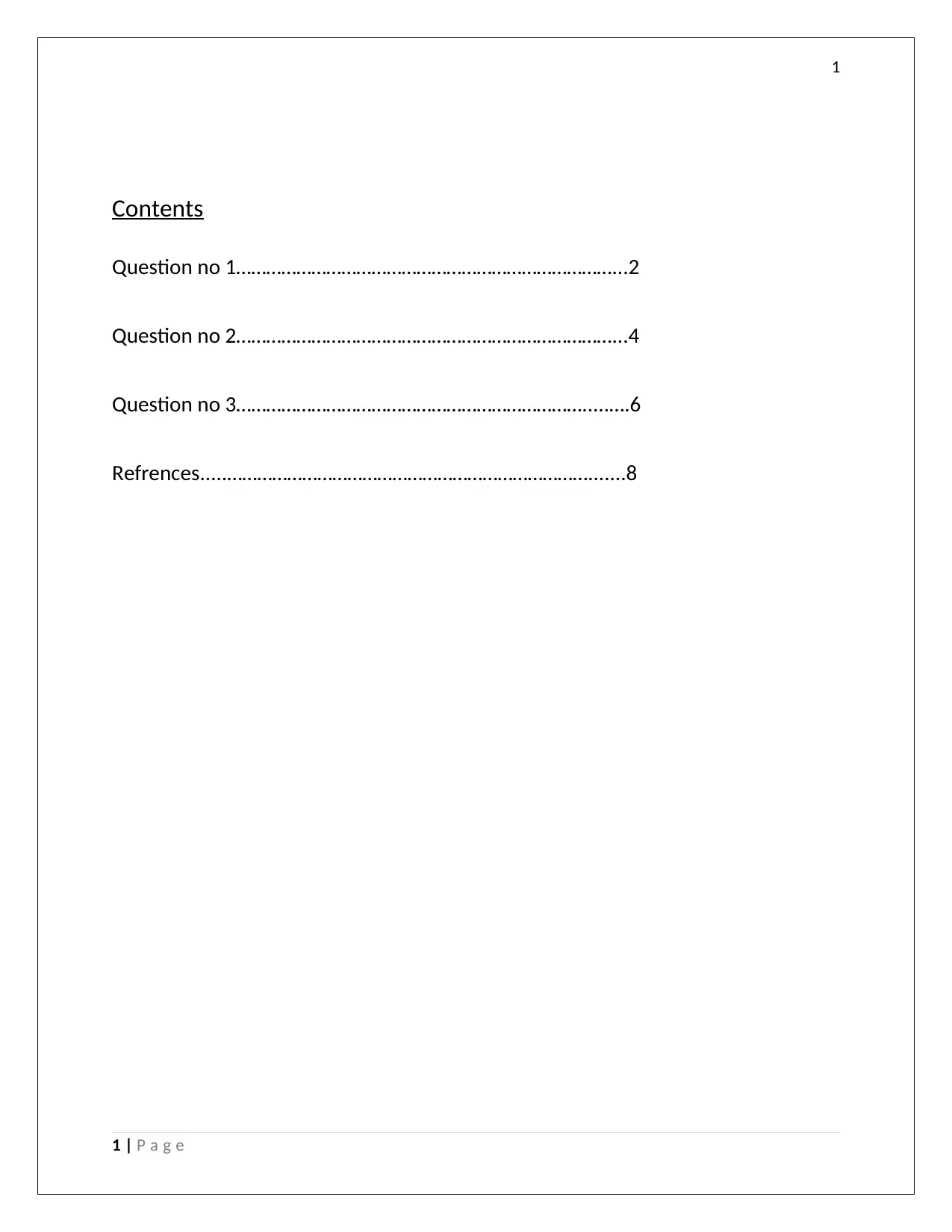
1
Contents
Question no 1…………………………………………………………………...2
Question no 2…………………………………………………………………...4
Question no 3…………………………………………………………….....….6
Refrences.....……………………………………………………………….......8
1 | P a g e
Contents
Question no 1…………………………………………………………………...2
Question no 2…………………………………………………………………...4
Question no 3…………………………………………………………….....….6
Refrences.....……………………………………………………………….......8
1 | P a g e
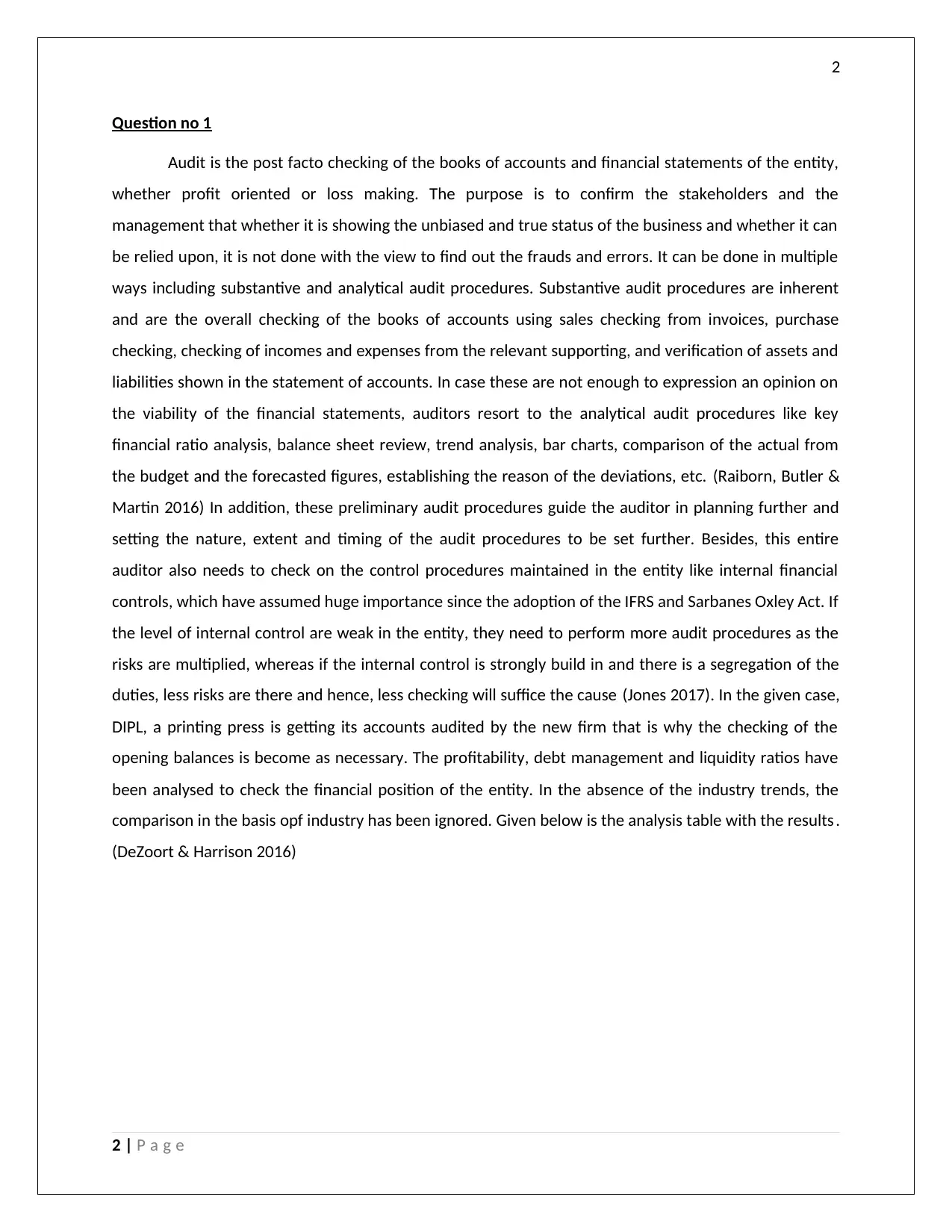
2
Question no 1
Audit is the post facto checking of the books of accounts and financial statements of the entity,
whether profit oriented or loss making. The purpose is to confirm the stakeholders and the
management that whether it is showing the unbiased and true status of the business and whether it can
be relied upon, it is not done with the view to find out the frauds and errors. It can be done in multiple
ways including substantive and analytical audit procedures. Substantive audit procedures are inherent
and are the overall checking of the books of accounts using sales checking from invoices, purchase
checking, checking of incomes and expenses from the relevant supporting, and verification of assets and
liabilities shown in the statement of accounts. In case these are not enough to expression an opinion on
the viability of the financial statements, auditors resort to the analytical audit procedures like key
financial ratio analysis, balance sheet review, trend analysis, bar charts, comparison of the actual from
the budget and the forecasted figures, establishing the reason of the deviations, etc. (Raiborn, Butler &
Martin 2016) In addition, these preliminary audit procedures guide the auditor in planning further and
setting the nature, extent and timing of the audit procedures to be set further. Besides, this entire
auditor also needs to check on the control procedures maintained in the entity like internal financial
controls, which have assumed huge importance since the adoption of the IFRS and Sarbanes Oxley Act. If
the level of internal control are weak in the entity, they need to perform more audit procedures as the
risks are multiplied, whereas if the internal control is strongly build in and there is a segregation of the
duties, less risks are there and hence, less checking will suffice the cause (Jones 2017). In the given case,
DIPL, a printing press is getting its accounts audited by the new firm that is why the checking of the
opening balances is become as necessary. The profitability, debt management and liquidity ratios have
been analysed to check the financial position of the entity. In the absence of the industry trends, the
comparison in the basis opf industry has been ignored. Given below is the analysis table with the results .
(DeZoort & Harrison 2016)
2 | P a g e
Question no 1
Audit is the post facto checking of the books of accounts and financial statements of the entity,
whether profit oriented or loss making. The purpose is to confirm the stakeholders and the
management that whether it is showing the unbiased and true status of the business and whether it can
be relied upon, it is not done with the view to find out the frauds and errors. It can be done in multiple
ways including substantive and analytical audit procedures. Substantive audit procedures are inherent
and are the overall checking of the books of accounts using sales checking from invoices, purchase
checking, checking of incomes and expenses from the relevant supporting, and verification of assets and
liabilities shown in the statement of accounts. In case these are not enough to expression an opinion on
the viability of the financial statements, auditors resort to the analytical audit procedures like key
financial ratio analysis, balance sheet review, trend analysis, bar charts, comparison of the actual from
the budget and the forecasted figures, establishing the reason of the deviations, etc. (Raiborn, Butler &
Martin 2016) In addition, these preliminary audit procedures guide the auditor in planning further and
setting the nature, extent and timing of the audit procedures to be set further. Besides, this entire
auditor also needs to check on the control procedures maintained in the entity like internal financial
controls, which have assumed huge importance since the adoption of the IFRS and Sarbanes Oxley Act. If
the level of internal control are weak in the entity, they need to perform more audit procedures as the
risks are multiplied, whereas if the internal control is strongly build in and there is a segregation of the
duties, less risks are there and hence, less checking will suffice the cause (Jones 2017). In the given case,
DIPL, a printing press is getting its accounts audited by the new firm that is why the checking of the
opening balances is become as necessary. The profitability, debt management and liquidity ratios have
been analysed to check the financial position of the entity. In the absence of the industry trends, the
comparison in the basis opf industry has been ignored. Given below is the analysis table with the results .
(DeZoort & Harrison 2016)
2 | P a g e
⊘ This is a preview!⊘
Do you want full access?
Subscribe today to unlock all pages.

Trusted by 1+ million students worldwide
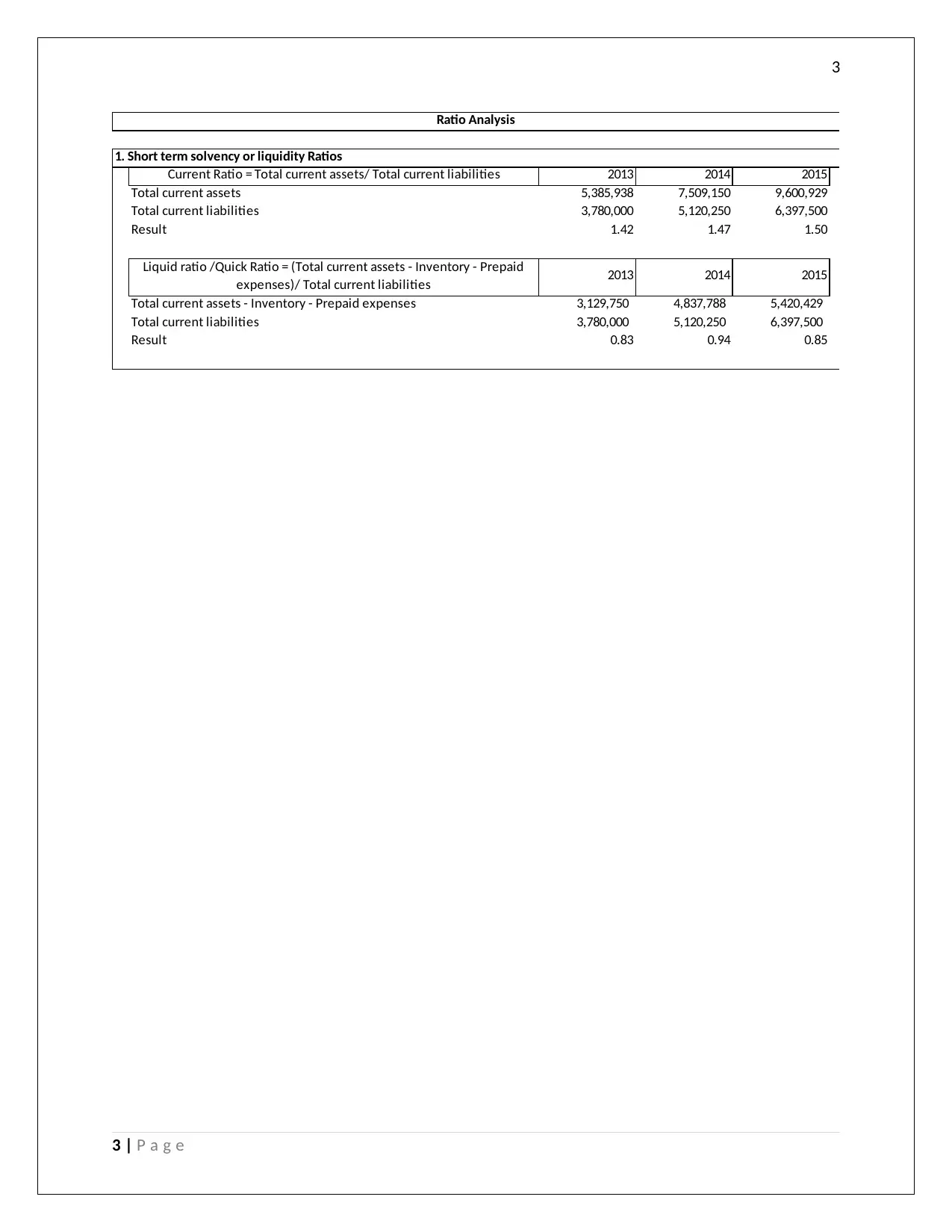
3
1. Short term solvency or liquidity Ratios
2013 2014 2015
Total current assets 5,385,938 7,509,150 9,600,929
Total current liabilities 3,780,000 5,120,250 6,397,500
Result 1.42 1.47 1.50
2013 2014 2015
Total current assets - Inventory - Prepaid expenses 3,129,750 4,837,788 5,420,429
Total current liabilities 3,780,000 5,120,250 6,397,500
Result 0.83 0.94 0.85
Ratio Analysis
Current Ratio = Total current assets/ Total current liabilities
Liquid ratio /Quick Ratio = (Total current assets - Inventory - Prepaid
expenses)/ Total current liabilities
3 | P a g e
1. Short term solvency or liquidity Ratios
2013 2014 2015
Total current assets 5,385,938 7,509,150 9,600,929
Total current liabilities 3,780,000 5,120,250 6,397,500
Result 1.42 1.47 1.50
2013 2014 2015
Total current assets - Inventory - Prepaid expenses 3,129,750 4,837,788 5,420,429
Total current liabilities 3,780,000 5,120,250 6,397,500
Result 0.83 0.94 0.85
Ratio Analysis
Current Ratio = Total current assets/ Total current liabilities
Liquid ratio /Quick Ratio = (Total current assets - Inventory - Prepaid
expenses)/ Total current liabilities
3 | P a g e
Paraphrase This Document
Need a fresh take? Get an instant paraphrase of this document with our AI Paraphraser
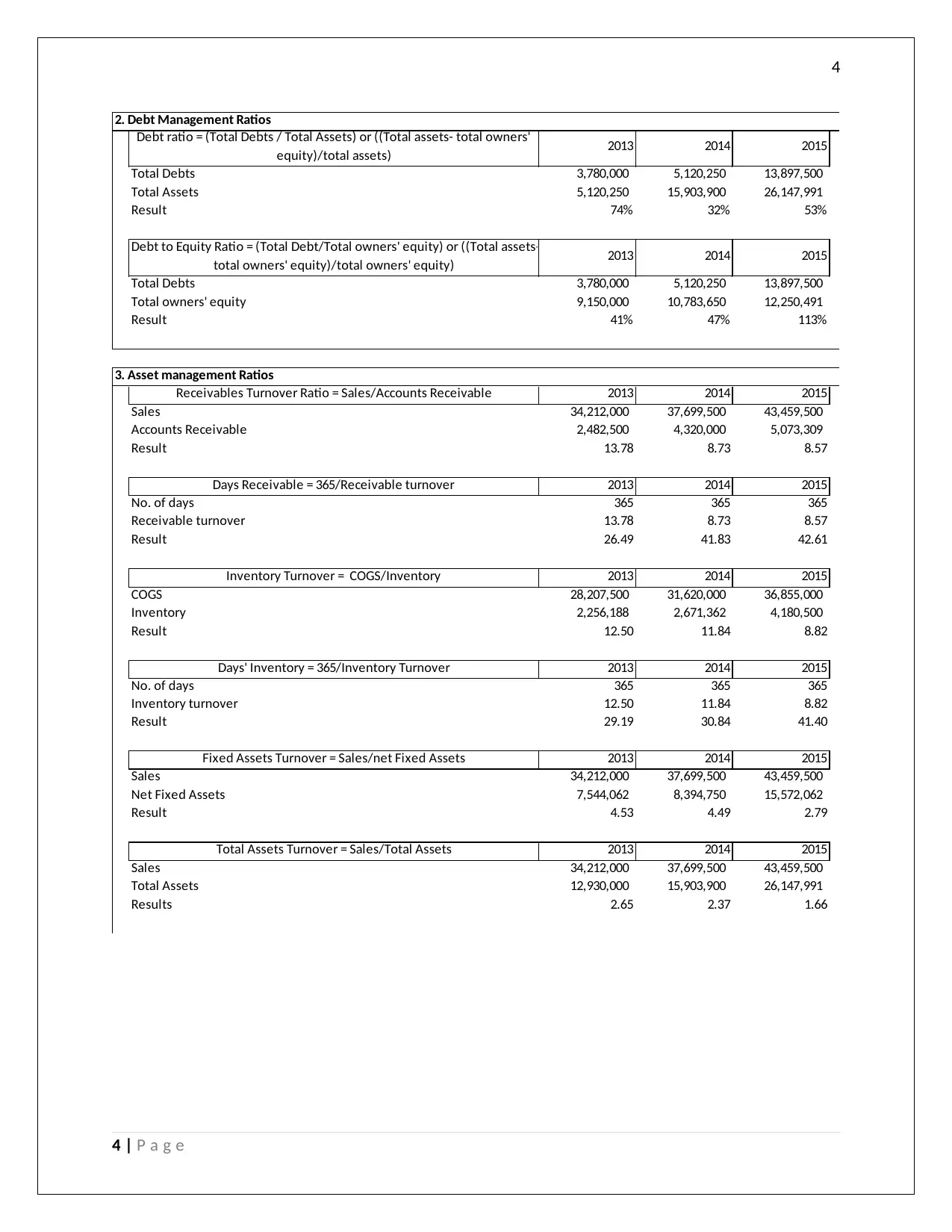
4
2. Debt Management Ratios
2013 2014 2015
Total Debts 3,780,000 5,120,250 13,897,500
Total Assets 5,120,250 15,903,900 26,147,991
Result 74% 32% 53%
2013 2014 2015
Total Debts 3,780,000 5,120,250 13,897,500
Total owners' equity 9,150,000 10,783,650 12,250,491
Result 41% 47% 113%
3. Asset management Ratios
2013 2014 2015
Sales 34,212,000 37,699,500 43,459,500
Accounts Receivable 2,482,500 4,320,000 5,073,309
Result 13.78 8.73 8.57
2013 2014 2015
No. of days 365 365 365
Receivable turnover 13.78 8.73 8.57
Result 26.49 41.83 42.61
2013 2014 2015
COGS 28,207,500 31,620,000 36,855,000
Inventory 2,256,188 2,671,362 4,180,500
Result 12.50 11.84 8.82
2013 2014 2015
No. of days 365 365 365
Inventory turnover 12.50 11.84 8.82
Result 29.19 30.84 41.40
2013 2014 2015
Sales 34,212,000 37,699,500 43,459,500
Net Fixed Assets 7,544,062 8,394,750 15,572,062
Result 4.53 4.49 2.79
2013 2014 2015
Sales 34,212,000 37,699,500 43,459,500
Total Assets 12,930,000 15,903,900 26,147,991
Results 2.65 2.37 1.66
Debt ratio = (Total Debts / Total Assets) or ((Total assets- total owners'
equity)/total assets)
Debt to Equity Ratio = (Total Debt/Total owners' equity) or ((Total assets-
total owners' equity)/total owners' equity)
Inventory Turnover = COGS/Inventory
Days' Inventory = 365/Inventory Turnover
Fixed Assets Turnover = Sales/net Fixed Assets
Total Assets Turnover = Sales/Total Assets
Receivables Turnover Ratio = Sales/Accounts Receivable
Days Receivable = 365/Receivable turnover
4 | P a g e
2. Debt Management Ratios
2013 2014 2015
Total Debts 3,780,000 5,120,250 13,897,500
Total Assets 5,120,250 15,903,900 26,147,991
Result 74% 32% 53%
2013 2014 2015
Total Debts 3,780,000 5,120,250 13,897,500
Total owners' equity 9,150,000 10,783,650 12,250,491
Result 41% 47% 113%
3. Asset management Ratios
2013 2014 2015
Sales 34,212,000 37,699,500 43,459,500
Accounts Receivable 2,482,500 4,320,000 5,073,309
Result 13.78 8.73 8.57
2013 2014 2015
No. of days 365 365 365
Receivable turnover 13.78 8.73 8.57
Result 26.49 41.83 42.61
2013 2014 2015
COGS 28,207,500 31,620,000 36,855,000
Inventory 2,256,188 2,671,362 4,180,500
Result 12.50 11.84 8.82
2013 2014 2015
No. of days 365 365 365
Inventory turnover 12.50 11.84 8.82
Result 29.19 30.84 41.40
2013 2014 2015
Sales 34,212,000 37,699,500 43,459,500
Net Fixed Assets 7,544,062 8,394,750 15,572,062
Result 4.53 4.49 2.79
2013 2014 2015
Sales 34,212,000 37,699,500 43,459,500
Total Assets 12,930,000 15,903,900 26,147,991
Results 2.65 2.37 1.66
Debt ratio = (Total Debts / Total Assets) or ((Total assets- total owners'
equity)/total assets)
Debt to Equity Ratio = (Total Debt/Total owners' equity) or ((Total assets-
total owners' equity)/total owners' equity)
Inventory Turnover = COGS/Inventory
Days' Inventory = 365/Inventory Turnover
Fixed Assets Turnover = Sales/net Fixed Assets
Total Assets Turnover = Sales/Total Assets
Receivables Turnover Ratio = Sales/Accounts Receivable
Days Receivable = 365/Receivable turnover
4 | P a g e
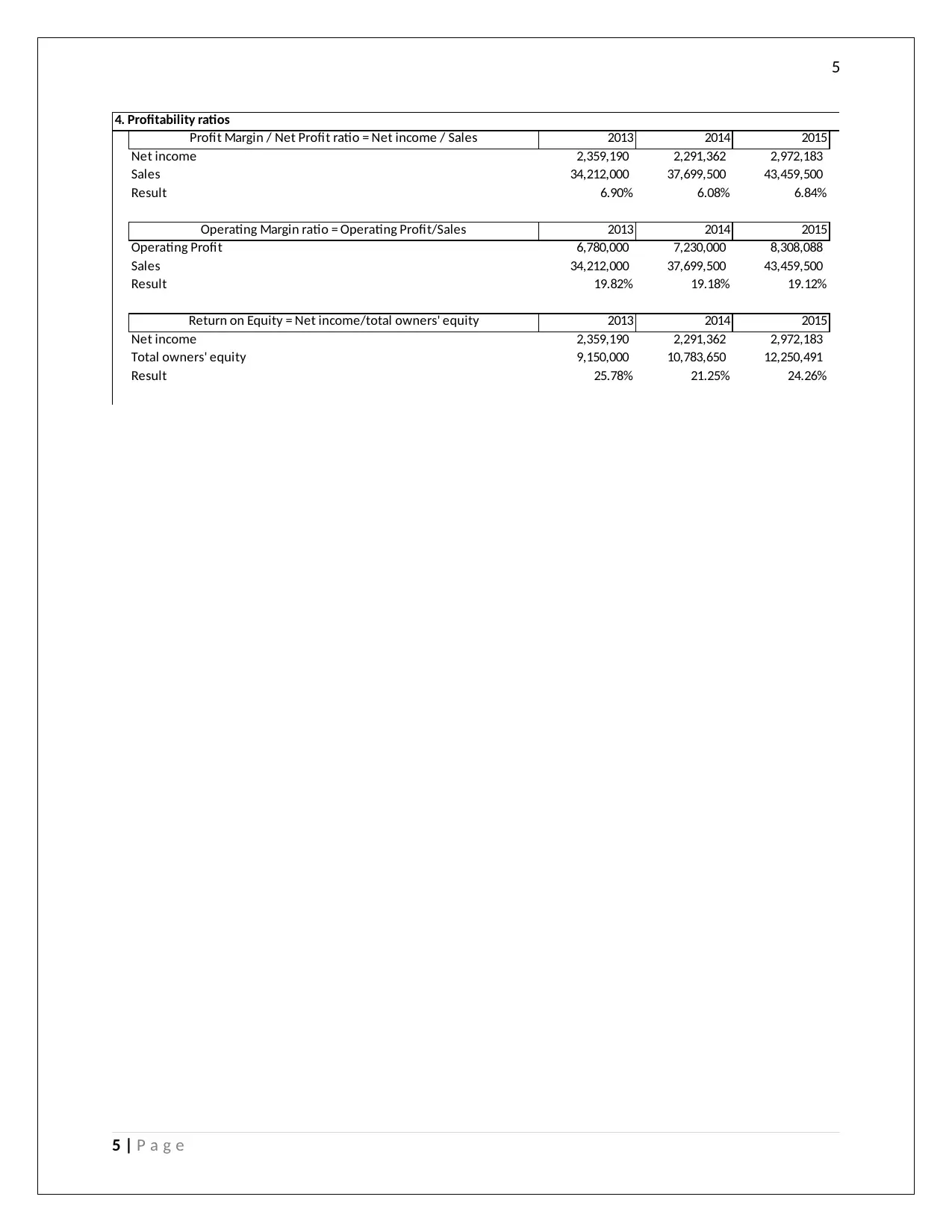
5
4. Profitability ratios
2013 2014 2015
Net income 2,359,190 2,291,362 2,972,183
Sales 34,212,000 37,699,500 43,459,500
Result 6.90% 6.08% 6.84%
2013 2014 2015
Operating Profit 6,780,000 7,230,000 8,308,088
Sales 34,212,000 37,699,500 43,459,500
Result 19.82% 19.18% 19.12%
2013 2014 2015
Net income 2,359,190 2,291,362 2,972,183
Total owners' equity 9,150,000 10,783,650 12,250,491
Result 25.78% 21.25% 24.26%
Profit Margin / Net Profit ratio = Net income / Sales
Operating Margin ratio = Operating Profit/Sales
Return on Equity = Net income/total owners' equity
5 | P a g e
4. Profitability ratios
2013 2014 2015
Net income 2,359,190 2,291,362 2,972,183
Sales 34,212,000 37,699,500 43,459,500
Result 6.90% 6.08% 6.84%
2013 2014 2015
Operating Profit 6,780,000 7,230,000 8,308,088
Sales 34,212,000 37,699,500 43,459,500
Result 19.82% 19.18% 19.12%
2013 2014 2015
Net income 2,359,190 2,291,362 2,972,183
Total owners' equity 9,150,000 10,783,650 12,250,491
Result 25.78% 21.25% 24.26%
Profit Margin / Net Profit ratio = Net income / Sales
Operating Margin ratio = Operating Profit/Sales
Return on Equity = Net income/total owners' equity
5 | P a g e
⊘ This is a preview!⊘
Do you want full access?
Subscribe today to unlock all pages.

Trusted by 1+ million students worldwide
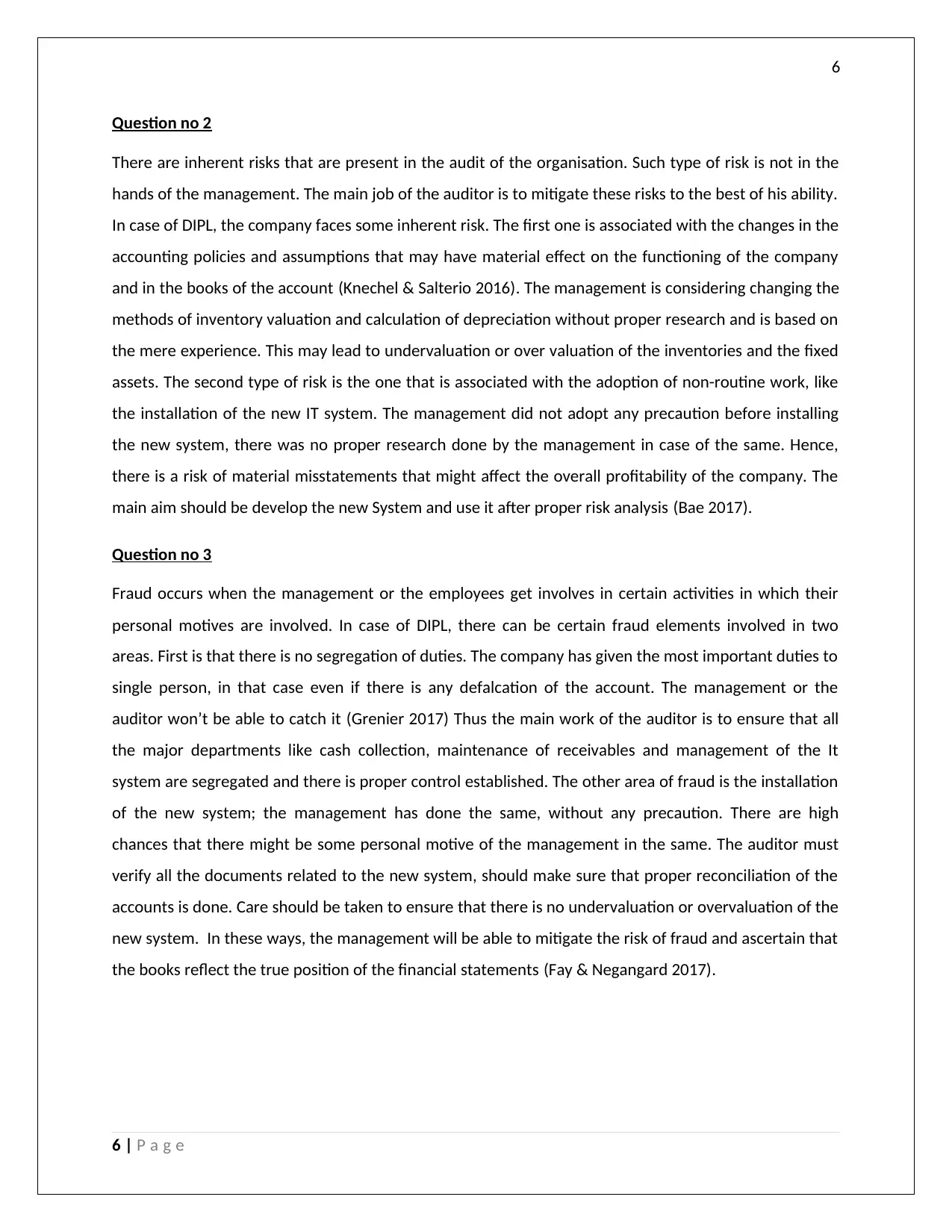
6
Question no 2
There are inherent risks that are present in the audit of the organisation. Such type of risk is not in the
hands of the management. The main job of the auditor is to mitigate these risks to the best of his ability.
In case of DIPL, the company faces some inherent risk. The first one is associated with the changes in the
accounting policies and assumptions that may have material effect on the functioning of the company
and in the books of the account (Knechel & Salterio 2016). The management is considering changing the
methods of inventory valuation and calculation of depreciation without proper research and is based on
the mere experience. This may lead to undervaluation or over valuation of the inventories and the fixed
assets. The second type of risk is the one that is associated with the adoption of non-routine work, like
the installation of the new IT system. The management did not adopt any precaution before installing
the new system, there was no proper research done by the management in case of the same. Hence,
there is a risk of material misstatements that might affect the overall profitability of the company. The
main aim should be develop the new System and use it after proper risk analysis (Bae 2017).
Question no 3
Fraud occurs when the management or the employees get involves in certain activities in which their
personal motives are involved. In case of DIPL, there can be certain fraud elements involved in two
areas. First is that there is no segregation of duties. The company has given the most important duties to
single person, in that case even if there is any defalcation of the account. The management or the
auditor won’t be able to catch it (Grenier 2017) Thus the main work of the auditor is to ensure that all
the major departments like cash collection, maintenance of receivables and management of the It
system are segregated and there is proper control established. The other area of fraud is the installation
of the new system; the management has done the same, without any precaution. There are high
chances that there might be some personal motive of the management in the same. The auditor must
verify all the documents related to the new system, should make sure that proper reconciliation of the
accounts is done. Care should be taken to ensure that there is no undervaluation or overvaluation of the
new system. In these ways, the management will be able to mitigate the risk of fraud and ascertain that
the books reflect the true position of the financial statements (Fay & Negangard 2017).
6 | P a g e
Question no 2
There are inherent risks that are present in the audit of the organisation. Such type of risk is not in the
hands of the management. The main job of the auditor is to mitigate these risks to the best of his ability.
In case of DIPL, the company faces some inherent risk. The first one is associated with the changes in the
accounting policies and assumptions that may have material effect on the functioning of the company
and in the books of the account (Knechel & Salterio 2016). The management is considering changing the
methods of inventory valuation and calculation of depreciation without proper research and is based on
the mere experience. This may lead to undervaluation or over valuation of the inventories and the fixed
assets. The second type of risk is the one that is associated with the adoption of non-routine work, like
the installation of the new IT system. The management did not adopt any precaution before installing
the new system, there was no proper research done by the management in case of the same. Hence,
there is a risk of material misstatements that might affect the overall profitability of the company. The
main aim should be develop the new System and use it after proper risk analysis (Bae 2017).
Question no 3
Fraud occurs when the management or the employees get involves in certain activities in which their
personal motives are involved. In case of DIPL, there can be certain fraud elements involved in two
areas. First is that there is no segregation of duties. The company has given the most important duties to
single person, in that case even if there is any defalcation of the account. The management or the
auditor won’t be able to catch it (Grenier 2017) Thus the main work of the auditor is to ensure that all
the major departments like cash collection, maintenance of receivables and management of the It
system are segregated and there is proper control established. The other area of fraud is the installation
of the new system; the management has done the same, without any precaution. There are high
chances that there might be some personal motive of the management in the same. The auditor must
verify all the documents related to the new system, should make sure that proper reconciliation of the
accounts is done. Care should be taken to ensure that there is no undervaluation or overvaluation of the
new system. In these ways, the management will be able to mitigate the risk of fraud and ascertain that
the books reflect the true position of the financial statements (Fay & Negangard 2017).
6 | P a g e
Paraphrase This Document
Need a fresh take? Get an instant paraphrase of this document with our AI Paraphraser
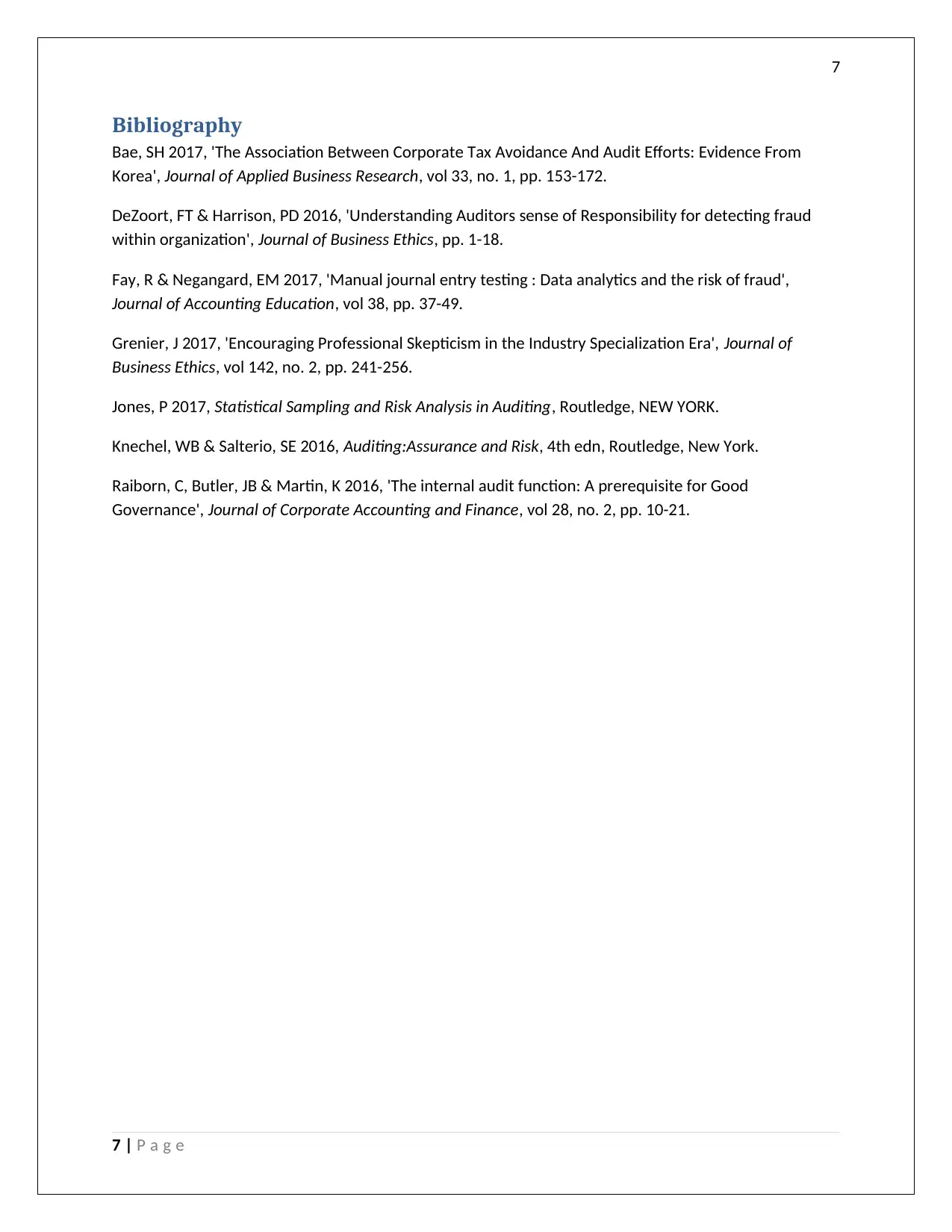
7
Bibliography
Bae, SH 2017, 'The Association Between Corporate Tax Avoidance And Audit Efforts: Evidence From
Korea', Journal of Applied Business Research, vol 33, no. 1, pp. 153-172.
DeZoort, FT & Harrison, PD 2016, 'Understanding Auditors sense of Responsibility for detecting fraud
within organization', Journal of Business Ethics, pp. 1-18.
Fay, R & Negangard, EM 2017, 'Manual journal entry testing : Data analytics and the risk of fraud',
Journal of Accounting Education, vol 38, pp. 37-49.
Grenier, J 2017, 'Encouraging Professional Skepticism in the Industry Specialization Era', Journal of
Business Ethics, vol 142, no. 2, pp. 241-256.
Jones, P 2017, Statistical Sampling and Risk Analysis in Auditing, Routledge, NEW YORK.
Knechel, WB & Salterio, SE 2016, Auditing:Assurance and Risk, 4th edn, Routledge, New York.
Raiborn, C, Butler, JB & Martin, K 2016, 'The internal audit function: A prerequisite for Good
Governance', Journal of Corporate Accounting and Finance, vol 28, no. 2, pp. 10-21.
7 | P a g e
Bibliography
Bae, SH 2017, 'The Association Between Corporate Tax Avoidance And Audit Efforts: Evidence From
Korea', Journal of Applied Business Research, vol 33, no. 1, pp. 153-172.
DeZoort, FT & Harrison, PD 2016, 'Understanding Auditors sense of Responsibility for detecting fraud
within organization', Journal of Business Ethics, pp. 1-18.
Fay, R & Negangard, EM 2017, 'Manual journal entry testing : Data analytics and the risk of fraud',
Journal of Accounting Education, vol 38, pp. 37-49.
Grenier, J 2017, 'Encouraging Professional Skepticism in the Industry Specialization Era', Journal of
Business Ethics, vol 142, no. 2, pp. 241-256.
Jones, P 2017, Statistical Sampling and Risk Analysis in Auditing, Routledge, NEW YORK.
Knechel, WB & Salterio, SE 2016, Auditing:Assurance and Risk, 4th edn, Routledge, New York.
Raiborn, C, Butler, JB & Martin, K 2016, 'The internal audit function: A prerequisite for Good
Governance', Journal of Corporate Accounting and Finance, vol 28, no. 2, pp. 10-21.
7 | P a g e
1 out of 8
Related Documents
Your All-in-One AI-Powered Toolkit for Academic Success.
+13062052269
info@desklib.com
Available 24*7 on WhatsApp / Email
![[object Object]](/_next/static/media/star-bottom.7253800d.svg)
Unlock your academic potential
Copyright © 2020–2025 A2Z Services. All Rights Reserved. Developed and managed by ZUCOL.





